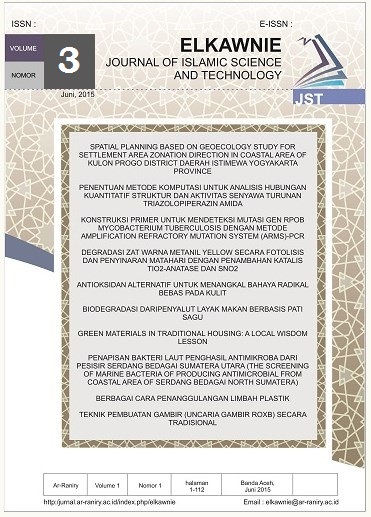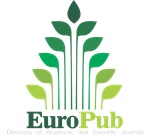Eksplorasi Bakteri Asam Laktat Kandidat Probiotik Dan Potensinya Dalam Menghambat Bakteri Patogen
DOI:
https://doi.org/10.22373/ekw.v3i2.1870Keywords:
lactic acid bacteria, probiotic, inhibition zoneAbstract
Penelitian ini bertujuan untuk mendapatkan isolat potensial bakteri asam laktat kandididat probiotik yang mampu menghambat pertumbuhan bakteri patogen. Terdapat 3 tahap dalam penelitian yaitu isolasi, karakterisasi dan uji potensi bakteri asam laktat dalam menghambat bakteri patogen. Sumber isolat bakteri asam laktat diperoleh dari susu fermentasi, sawi fermentasi dan saluran pencernaan ikan. Tiga jenis bakteri patogen yang digunakan meliputi: Eschericia coli, Salmonella thypii dan Sghigella dysentriae. Ketiga jenis bakteri ini mewakili bakteri yang umum menyerang saluran pencernaan. Enam isolat bakteri asam laktat berhasil diisolasi dari 3 jenis sampel berbeda. Isolat tersebut adalah BAL01, BAL02, BAL03, BAL04, BAL05 dan BAL06. Kemampuan antagonis masing – masing isolat berbeda dalam menghambat bakteri patogen. Isolat BAL01 DAN BAL02 mampu menghambat E. coli dengan zona hambat sebesar 9.25 mm. Isolat BAL02 mampu menghambat S. Thypii dengan zona hambat sebesar 8.5 mm. Sedangkan zona hambat terbesar dalam menghambat S. dysentriae ditunjukkan oleh isolat BAL03 yaitu sebesar 11 mm.References
Fardiaz S, Jenie BSL, Solihati A.1997. Isolasi dan Seleksi Bakteri
Asam Laktat yang bersifat Antimikroba dari Sauerkraut.
Jurnal Teknologi dan Industri Pangan 8(3).
Gildberg, A. Mikkelsen, Sandaker, E. and Ring, E. 1997. Probiotic
Effect of Lactid Acid Bacteria in The Feed on Growth
and Survival of Fry of Atlantic Cod (Gadus morhua)
Hydrobiologia. Appl, Microbiology. 352: 279-285.
Jini R, Swapna HC, Rai AK, Vrinda R, Halami PM, Sachindra
NM, Bhaskar N. 2011. Isolation and Characterization of
Potential Lactic Acid Bacteria (LAB) from Freshwater
Fish Processing Wastes for Application in Fermentative
Utilisation of Fish Processing Waste. Brazilian Journal of
Microbiology 42: 1516-1525.
Ngendaung S. 2001. Study on Bacterion-Producing Lactic
Acid Bacteria from Fermented Foods. Master Thesis,
Microbiology, Kasetsart university, Bangkok.
Nissen-Meyer, J., H. Holo, S. Havastein, K. Sketten, dan I.F. Nes.
A novel lactococcal bacteriocin whose activity depend
on the complementary action of two peptides. J. Bacteriol.
(4): 5686-5692.
Sunaryanto, R., Martius, E & Marwanto, E. 2014. Uji Kemampuan
Lactobacillus casei sebagai Agensia Probiotik. Jurnal
Bioteknologi & Biosains Indonesia. 1(1):2442-2602.
Utami, D.A. 2011. Karakterisasi Molekular Bakteri Asam Laktat
(BAL) Probiotik dengan Gen 16s rRNA yang Berpotensi
Menghasilkan Bakteriosin Fermentasi Sirsak (Annona
Maricata .L) Di Sumatera Barat. Tesis. Program Pascasarjana
Universitas Andalas Padang
Vuyst, L. dan E.J. Vandamme. 1994. Antimicrobial potential of
lactic acid bacteria In: De Vuyst, L. dan E.J. Vandamme.
Bacteriocins of lactic acid bacteria: microbiology, genetic
and application. London: Blackie Academic & Professional.
Downloads
Published
Issue
Section
License
Proposed Policy for Journals That Offer Open Access Authors who publish with the Elkawnie journal agree to the following terms:
a. Authors retain copyright and grant the journal right of first publication with the work simultaneously licensed under a Creative Commons Attribution License that allows others to share the work with an acknowledgement of the work's authorship and initial publication in this journal.
b. Authors are able to enter into separate, additional contractual arrangements for the non-exclusive distribution of the journal's published version of the work (e.g., post it to an institutional repository or publish it in a book), with an acknowledgement of its initial publication in this journal.
c. Authors are permitted and encouraged to post their work online (e.g., in institutional repositories or on their website) prior to and during the submission process, as it can lead to productive exchanges, as well as earlier and greater citation of published work (see The Effect of Open Access).

























